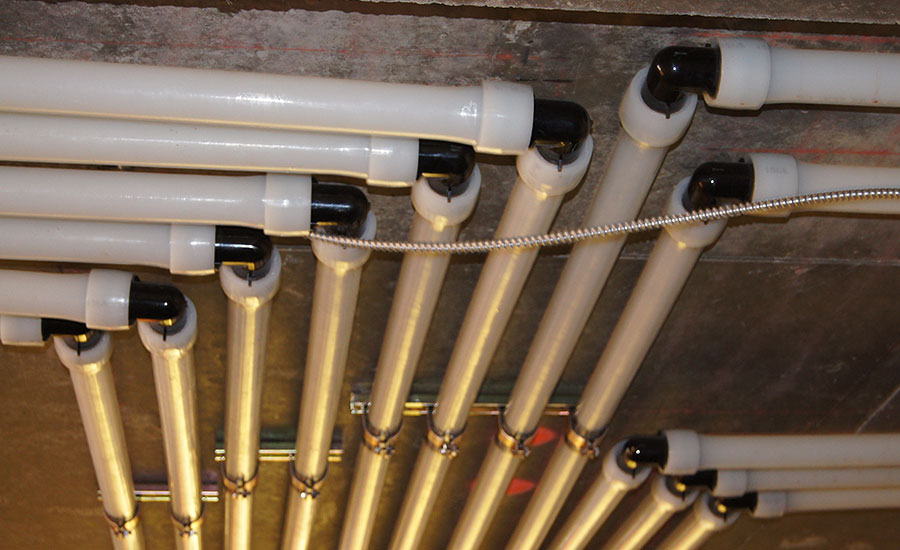Best Practices for installing PEX-a in commercial plumbing applications

Manufactured solutions are always better for hanging PEX than field-expedient ‘innovations.’ Uponor photo

Retrofitting PEX can make a complicated job go by quickly and cost-effectively. Uponor photo.


The piping world is changing. Crosslinked polyethylene piping, best known as PEX, is increasingly being chosen over copper, CPVC and other metal and plastic piping materials in commercial plumbing applications due to its lower cost, flexibility and durability. When installing it, however, it’s important to understand its properties as well as heed certain practices that will allow it to operate as designed.
The Properties of PEX
Three types of PEX exist: PEX-a, PEX-b and PEX-c. PEX-a, the type we’re mostly concerned with here, is extruded above its crystal melting temperature using the Engel Method. This creates uniform crosslinking that provides greater flexibility and increased thermal and elastic memory.
PEX-a’s thermal memory refers to the ability to repair accidental kinks in the piping with a controlled heating source, such as a heat gun. PEX-a’s elastic memory means it can expand up to three times its diameter and then shrink back down to its original size. This characteristic makes the piping highly resistant to freeze damage and also allows for the use of ASTM F1960 expansion fittings for piping connections. An F1960 expansion connection is a simple, solid, durable connection which requires the use of an expansion tool to expand the pipe and expansion ring before inserting a larger internal diameter fitting. Once the fitting is inserted, the piping and expansion ring naturally compresses over it, making a pipe-joint connection that actually grows stronger over time.
It’s important to consider temperature’s role in this connection. The colder the temperature of the pipe, the slower the contraction time, so warming the expansion rings prior to installation is advised — it can be as simple as keeping the rings in your pocket. However, do not use heat guns to speed up contraction time, especially on engineered polymer fittings.
Fitting options include EP or brass. The EP fittings are extremely light, yet strong, providing superior mechanical properties. Still, it is important not to expose these fittings to open flame, organic chemicals, thread sealants, solvents, adhesives or strong acids and bases. Furthermore, do not solder or braze within 18 inches of EP fittings. Unlike brass fittings, EP fittings cannot be reclaimed once joined to a pipe, although they are less expensive to replace.
Hanger Spacing and Supports
Different installation practices apply for dealing with horizontal and vertical runs of PEX-a piping.
For horizontal installations, use copper tube size hangers and support the bare PEX according to the applicable code. Depending on the pipe size and code, you will need to space the hangers between 32- and 48 inches apart.
Vertical installations are classified as either in-wall or riser applications. Again, use CTS hangers and support the bare PEX according to the applicable code. For in-wall installations, hangers should be spaced five feet apart. For risers, which run between building stories, have a riser clamp at the base of each floor, as well as a mid-story guide to maintain piping alignment in the stud cavity.
A very convenient way to increase spacing between hangers and thus save on installation costs is to utilize manufactured supports. Used appropriately, manufactured PEX pipe supports will allow hanger spacing similar to that of copper, or between six- and eight feet. Important to note is that some PEX pipe supports cannot be placed in the pipe span containing fittings; on those runs, hanger spacing must revert to that of bare PEX. Thus, it’s advisable to do a hanger layout that will allow for the full benefits of the manufactured PEX pipe support product.
Thermal Expansion and Contraction
It is characteristic of PEX-a piping to expand and contract at a rate of 1.1 inches per 100 feet per 10 degrees Fahrenheit of temperature differential. Utilizing a manufactured support in conjunction with anchor points, can reduce this expansion and contraction rate to a more-than-acceptable level.
Place anchor points at 65 feet for domestic hot water and 150 feet for domestic cold water. With a loop and clevis system, using manufactured supports — and anchoring with fixed points – can reduce the rate to 0.22 inches per 100 feet per 10 degrees temperature differential, or by 75 percent. In a strut system, the same procedure reduces the rate to 0.04 inches per 100 feet per 10 degrees temperature differential, a 93 percent reduction. Interestingly, the strut scenario actually reduces the expansion-contraction rate to less than copper’s, which is 0.11 inches per 100 feet per 10 degrees temperature differential.
As already noted, use a copper tube size riser clamp on the base of each floor to control for expansion and contraction in the risers. For hot water, add an extra clamp at the top of every-other floor; for cold water, add one at the top of every fourth floor. Mid-story guides should consist of an iron pipe size support and are meant to guide the pipe and maintain direction.
Specific Applications
Outlined below are the benefits and methods of installing PEX-a in various applications:
Public Fixtures: PEX-a is an ideal material to use with public fixtures, such as urinals and water closets utilizing flush valves. It can reduce surge pressures by 18- to 40 percent more than metallic piping. PEX-a also has superior acoustical properties, absorbing 10- to 100 times more sound, measured in decibels per centimeter, than metal piping. For installation in these scenarios, it is ideal to keep the PEX-a header higher, allowing for longer, sweeping bends down to the fixture connections. It is important to note that most codes currently require hammer arrestors for fast-acting valves, regardless of pipe material.
Fire-Resistant Construction: PEX-a piping is rated for up to three-hour fire assemblies per ASTM E119. Listings include assemblies for combustible wood-frame construction as well as non-combustible steel-frame and concrete construction. E119 listings are maintained by each respective manufacturer and are product specific. For Uponor’s specific E119 listings, refer to the Uponor Plumbing Design Assistance Manual or the Underwriters Laboratory Online Certifications Directory.
Plenum Installations:Uponor PEX-a piping systems, for example, are listed for use in return-air plenums per ASTM E84. A return-air plenum is an un-ducted ceiling space being used for air circulation. It’s important not to have PEX-a Pipe Support segments less than 48 inches long in a return-air plenum, and the space should not have more than 18 inches of bare PEX or fittings. This also applies to PEX-a Pipe Support installed in the vertical position. PEX-a pipe can also be installed in return-air plenums with an E84-listed insulation when the use of PEX-a Pipe Support is not practical.
Through-Penetration Firestops:PEX-a pipe carries numerous listings through ASTM E814 for through-penetrations. Listings range from one-hour penetrations for combustible wood-frame construction to three-hour non-combustible listings for steel-frame and concrete construction. These listings are maintained by the various firestop manufacturers such as Hilti, 3M, Specified Technologies, Inc. and RectorSeal.
Horizontal Directional Drilling:This application is used when trenching or excavating is not practical. The Plastic Piping Institute TR-46 “Guidelines for Use of Mini-Horizontal Directional Drilling for Placement of High Density Polyethylene Pipe” allow for runs of up to 600 feet in depths up to 15 feet, using pipe with a maximum diameter of 12 inches. Ensure that the pipe does not come into contact with any sharp objects or exceed the minimum bend radius of six times the outside diameter. It’s also key to pressure-test the pipe after installation to ensure system integrity. (See below).
Pressure Testing:Air and hydrostatic testing are both approved for PEX-a pipe. Before testing, allow the system pressure to stabilize and always test in accordance with local codes. If conducting a hydrostatic test, do not allow the water-filled piping to freeze. Expect slight fluctuations of pressure caused by ambient temperature changes.
For residential pressure testing, the minimum test pressure should be 25 pounds per square inch above working pressure, or 100 psi.
For commercial pressure testing, condition the PEX-a to 1.5 times the test pressure then allow the pressure to drop to 10 psi before re-pressurizing to 1.5 times the test pressure. Repeat this pressurization/depressurization routine for 30 minutes. Following this, quickly relieve the pressure to actual test levels, close the valve and start the pressure test timer after observing a slight rise in pressure.
System Flushing:Flush the system with clean, potable water to remove any construction debris. Where required by code, disinfect per AWWA C651-86 with either a chlorine solution of 50 parts per million (ppm) for 24 hours or a chlorine solution of 200 ppm for three hours. Be sure to flush the system with potable water after chlorine disinfection.
PEX-a piping lends itself to an abundance of applications where it takes the best of traditional, metallic piping and combines it with superior physical properties.
PEX-a Handling Guidelines:
- Follow factory-recommended installation instructions.
- Keep pipe in original packaging until ready for install.
- Do not store outdoors.
- Do not use PEX pipe where temperatures and pressures exceed ratings.
- Do not exceed maximum direct ultraviolet exposure
- Do not use PEX pipe for an electrical ground; PEX is not a conductive material.
- Do not weld, glue or use adhesives on PEX pipe.
- Do not apply open flame to PEX pipe.
- Do not solder, braze, weld or fusion-weld within 18 inches of any PEX pipe in the same water line. Make all hot-work connections prior to making the ProPEX connection.
- Do not spray on or allow exposure to any organic chemicals, pesticides, strong acids or strong bases.
- Do not allow petroleum or solvent-based paints on PEX pipe.
- Do not install PEX pipe within six inches of any gas appliance vents, the exception being double-wall B-vents or plastic vents that have a minimum clearance of 1 inch.
- Do not install PEX within 18 inches of a connection to a water heater, unless otherwise allowed by local code.
- Do not install PEX within 12 inches of any recessed light fixture, unless the PEX is protected with suitable insulation or the can light is Insulation Contact-rated.
- Do not install PEX pipe within five feet of direct view from fluorescent lighting without sleeving the pipe with a UV-blocking material.
- Do not install PEX pipe between the tub/shower valve and tub spout.
"This article was originally posted on ww.reevesjournal.com."
Looking for a reprint of this article?
From high-res PDFs to custom plaques, order your copy today!








